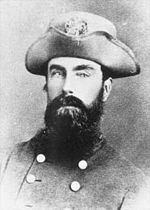
Brigadier General Maxcy Gregg
Maxcy Gregg (August 1, 1814 – December 15, 1862) was a lawyer, soldier in the United States Army during the Mexican-American War, and a Confederate brigadier general during the American Civil War who was killed at the Battle of Fredericksburg.
Early life[]
Gregg was born in Columbia, South Carolina, the grandson of Esek Hopkins, commodore of the Continental Navy. He was educated at South Carolina College (now called the University of South Carolina). He practiced law with his father, and fought in the Mexican-American War as a major in the 12th U.S. Infantry. Gregg had many scholarly pursuits, including astronomy, botany, ornithology, and languages, and owned his own private observatory.
Civil War[]
Gregg was a major proponent of secession prior to the commencement of the Civil War. In 1858, he issued the secessionists' manifesto in a pamphlet entitled, "An Appeal to the State Rights Party of South Carolina." In it, Gregg argued that Carolinians had looked unfavorably upon and rejected incorporation into the Democratic Party since the tariff controversy. Andrew P. Calhoun, James Tradewell, A.C. Garlington, and W.E. Martin also contributed statements to the "Appeal."[1] When South Carolina seceded from the Union in December 1860, Gregg helped organize the 1st South Carolina Volunteers, and served as the regiment's first colonel. He became a brigadier general and served in A. P. Hill's Light Division. His brigade played a prominent role in Hill's assault on the Union lines at the Battle of Gaines' Mill. Gregg gained prominence at the Second Battle of Bull Run when his men repulsed six Union assaults, and he served in Robert E. Lee's Maryland Campaign. At Antietam he was wounded in the thigh by the same bullet that killed Brig. Gen. Lawrence O'Bryan Branch.
Death[]
At Fredericksburg, Union Maj. Gen. George Meade's troops penetrated the lines of the Light Division and Gregg was shot in the spine, and he died two days later. He is buried in Elmwood Cemetery, Columbia, South Carolina.
In popular media[]
He was portrayed by actor Buck Taylor in the 2003 film Gods and Generals.
See also[]
Notes[]
- ↑ Manisha Sinha, The Counter-Revolution of Slavery: Politics and Ideology in Antebellum South Carolina (Chapel Hill: University of North Carolina Press, 2000), 193.
References[]
- Eicher, John H., and David J. Eicher. Civil War High Commands. Stanford, CA: Stanford University Press, 2001. ISBN 0-8047-3641-3.
External links[]
The original article can be found at Maxcy Gregg and the edit history here.